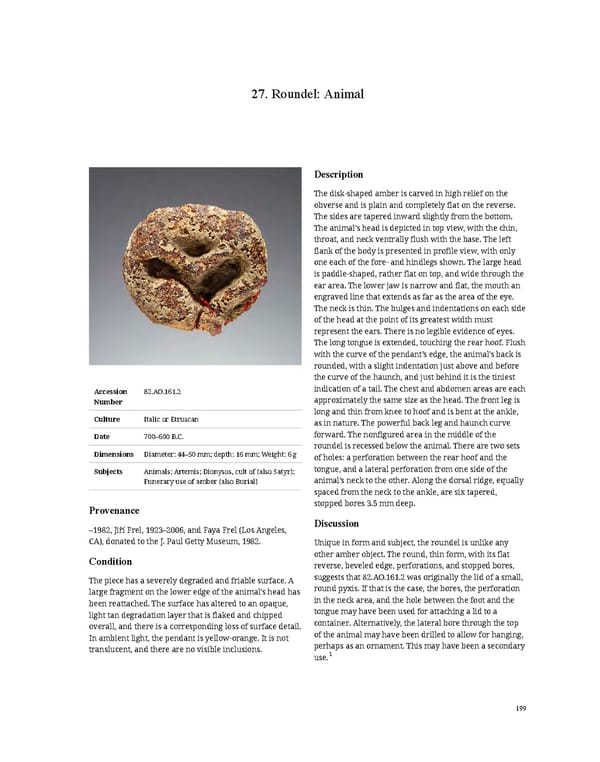27. Roundel: Animal Description The disk-shaped amber is carved in high relief on the obverse and is plain and completely flat on the reverse. The sides are tapered inward slightly from the bottom. The animal’s head is depicted in top view, with the chin, throat, and neck ventrally flush with the base. The left flank of the body is presented in profile view, with only one each of the fore- and hindlegs shown. The large head is paddle-shaped, rather flat on top, and wide through the ear area. The lower jaw is narrow and flat, the mouth an engraved line that extends as far as the area of the eye. The neck is thin. The bulges and indentations on each side of the head at the point of its greatest width must represent the ears. There is no legible evidence of eyes. The long tongue is extended, touching the rear hoof. Flush with the curve of the pendant’s edge, the animal’s back is rounded, with a slight indentation just above and before the curve of the haunch, and just behind it is the tiniest Accession 82.AO.161.2 indication of a tail. The chest and abdomen areas are each Number approximately the same size as the head. The front leg is long and thin from knee to hoof and is bent at the ankle, Culture Italic or Etruscan as in nature. The powerful back leg and haunch curve Date 700–600 B.C. forward. The nonfigured area in the middle of the roundel is recessed below the animal. There are two sets Dimensions Diameter: 44–50 mm; depth: 16 mm; Weight: 6 g of holes: a perforation between the rear hoof and the Subjects Animals; Artemis; Dionysos, cult of (also Satyr); tongue, and a lateral perforation from one side of the Funerary use of amber (also Burial) animal’s neck to the other. Along the dorsal ridge, equally spaced from the neck to the ankle, are six tapered, Provenance stopped bores 3.5 mm deep. –1982, Jiří Frel, 1923–2006, and Faya Frel (Los Angeles, Discussion CA), donated to the J. Paul Getty Museum, 1982. Unique in form and subject, the roundel is unlike any Condition other amber object. The round, thin form, with its flat reverse, beveled edge, perforations, and stopped bores, The piece has a severely degraded and friable surface. A suggests that 82.AO.161.2 was originally the lid of a small, large fragment on the lower edge of the animal’s head has round pyxis. If that is the case, the bores, the perforation been reattached. The surface has altered to an opaque, in the neck area, and the hole between the foot and the light tan degradation layer that is flaked and chipped tongue may have been used for attaching a lid to a overall, and there is a corresponding loss of surface detail. container. Alternatively, the lateral bore through the top In ambient light, the pendant is yellow-orange. It is not of the animal may have been drilled to allow for hanging, translucent, and there are no visible inclusions. perhaps as an ornament. This may have been a secondary use.1 199
 Ancient Carved Ambers in the J. Paul Getty Museum Page 208 Page 210
Ancient Carved Ambers in the J. Paul Getty Museum Page 208 Page 210